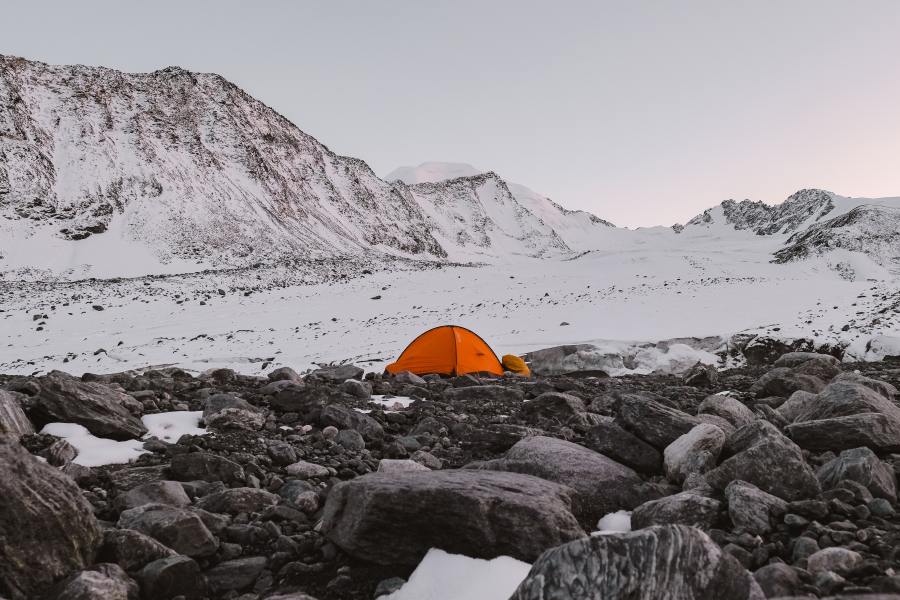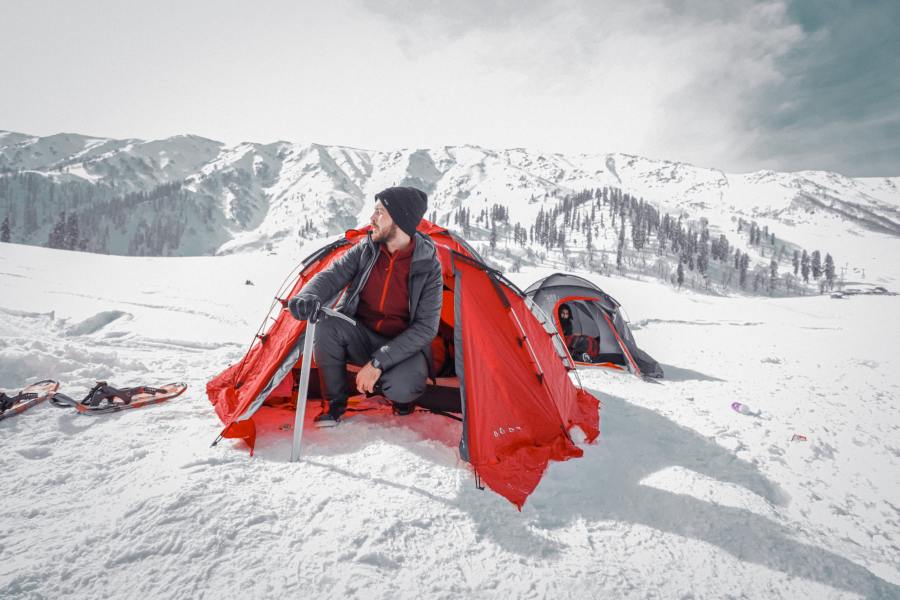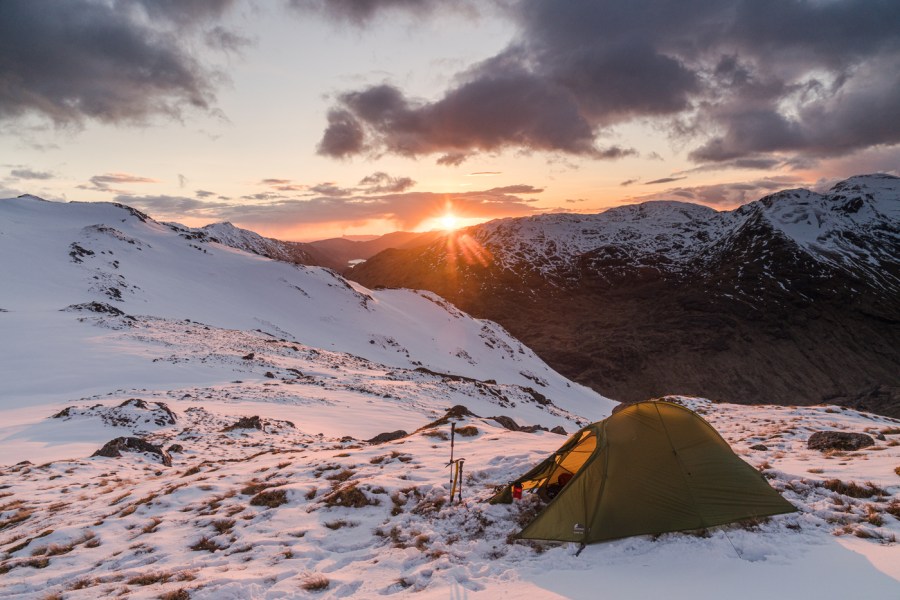Our contributing editor David Lintern shares some hard-won tips on how to wild camp safely in snowy and wintery conditions.
Winter can be the most magical time of year for wild camping, but before we rush out in search of the deep and crisp and even, it’s worth noting that winter snows in the UK are rarely all of those things at the same time.
We may not have as many words for snow as the Inuit and Yupik, but even westerners distinguish between powder and neve, not to mention breakable crust or even mashed potato. The snowline can vary wildly from one week to the next, even in Highland Scotland. ‘Winter conditions’ means more than one thing, and so we need to stay flexible on our winter wild camp missions. That often means a heavier bag, more kit and the skills to use it, and more planning ahead of stepping out.
Words: David Lintern | Main image: a snowy pitch on the traverse of Streap. Credit: David Lintern
How to winter wild camp
Planning your camp
You should carry (and know how to use) an axe regardless, but early season snowfall may call for snowshoes as much as crampons. A big thaw can mean it’s worth packing the microspikes for the walk in on that icy path. Keep an eye on the weather forecasts. Regular posts by winter guides on Facebook community forums can help you understand conditions in a particular area.
Winter loads are heavy, and any snow on the approach will often be of poor quality, making progress slow and tiring. When planning, have a think about a place you can make camp before heading off with a lighter load. A col or valley between some tops you have your sights on can make a fine basecamp. Be mindful of expected wind direction and avalanche risk and use web forecasting tools to inform your thinking.
Can you combine a night or two out under the stars with one in a bothy? These are a godsend in the darker months, especially if you are out for a few days, and can help get your kit dry and aired. They are generally far less busy in the winter, too.
What happens when you get to the col and the wind is too strong, or the bothy is locked? The very best plans survive contact with the unexpected. Have a plan B and a plan C.
Choosing a pitch
Even if it’s deep and crisp, snow cover is rarely even. If cover is patchy, consider a pitch without snow. It’ll be warmer.

It’s always warmer to camp away from snow. Credit: Anna Shvets
On snow-covered ground, listen carefully. Hear running water underneath the snowpack? Back away slowly, this is not the pitch you are looking for!
Preparing a comfortable snow-covered pitch sometimes requires ‘Sintering’. This is a process of flattening the snow to a size a little bigger than your shelter, to avoid it melting underneath you in the night, which results in a very uneven mattress! Skis or snowshoes make the job easier; otherwise, walk out a patch of snow and clear away the excess. If possible, wait 30 minutes or so to let this flattened area freeze a little before setting up.
Winter camping tips
Keep your gas canister inside your sleeping bag, along with camera batteries and phone. They’ll all work better for longer when the mercury dips.
Dry your damp socks and gloves in duvet jacket pockets in the evening or your winter sleeping bag overnight.
Keep boots off the ground. Ideally, raise them onto a rucksack or bring them inside the tent. Some people use a plastic bag too. If you’ve been sweating into them all day they may still freeze, but it’ll be less of a hard freeze if they aren’t in direct contact with the snow. Remove the insoles to help air them out. I sometimes store these in my sleeping bag too!
Keep crampons out of the snow, or risk the straps becoming frozen solid overnight.
Wear a duvet jacket and insulated trousers to boost sleeping bag warmth. Insulated booties are also a great addition to winter kit.
A few snow pegs added to your regular peg set can really help with exposed, blustery camps. You can also use your axe and poles as extra anchors in mixed or snowy conditions.

Don’t forget your ice axe – it can even help to anchor your tent. Credit: Syed Qaarif Andrabi
A collapsible snow shovel can help prepare the ground, create a windbreak and makes an excellent stake in lieu of a peg. In deep snow, you can also dig a footwell in your porch. Cold air sinks and your tent will be warmer as a result.
Do not forget ski goggles, a spare hat and gloves (a few different pairs). Windchill can and does kill, and high winds will lift loose snow and reduce visibility (as well as whisk away stray gloves!)
Take extra food, especially things that you enjoy, are high in energy and easy to unwrap with gloves. Winter travel is incredibly hard work, especially with a big pack. I like pies and malt loaf all year round, but especially in winter!
If camping high, a larger pot is useful for melting snow in order to eat or drink. Allow a lot of extra time and fuel to melt snow for water.
A wide-necked Nalgene or similar water container is less likely to freeze at the opening. Store it upside down (the water pressure will reduce or prevent freezing). In the daytime, this can live inside the lid of your pack and at night double up as a hot water bottle.
A spare lantern or extra torch will make the long hours of winter inside the tent significantly more bearable.
READ MORE: James Forrest answers every new wild camper’s burning questions






